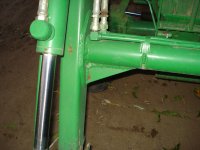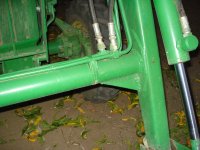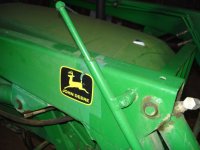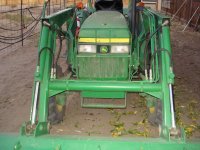I was doing some digging with my bucket the other day and didn't notice one end of the quick attach bucket had popped out of the loader arm. I ended up bending something because my quick attach will no longer line up when installing front attachments. The right side lines up and you can get the pin in the bucket, but the left side is then about 2-3" away from getting the quick attach pin into the bucket. I have to apply pressure with the loader arms by pushing into a tree or hard ground to line everything up to get the second pin in place. I can't see any obvious bends. I'm thinking about chaining up the right loader arm and trying to bend back using the loader hydraulics and the weight of the font end. Are there any other tricks I can try?
It would be nice to know where the bend is, but lots of times that's hard to determine. Still, take your time to do your best on finding just what bent and by how much.
We are going to need that info in one old metal workers trick I'm going to explain.
But first you have to understand the problem. It's not the bent metal so much as it is that when you bend metal to the yield point that so that it permanently deforms into a new shape it also stretches as it yields into the new shape. And although it is relatively simple matter to bend it back close to ts former shape, it can never be "unstretched". A bent tube that is straightened will be longer than it was before.
So a loader arm that has been bent can often be bend back to where it used to be in two dimensions...but it is now also slightly longer that what it once was.... so it's still off.
You see the problem; you can never bend it back to where it used to be. You can get close, but even if you line it up in two dimensions it will be off in the stretched dimension.
The trick is to bend the OTHER arm so that it matches the first one. But you can only do that if the bend is in the arm itself. Then it's pretty easy. Just isolate the second arm and bend it to match the first one. Go really slow and measure often. You should be able to get the bends to match up pretty closely.
I'll say it again: that trick only works when the bend is in the arm itself - but that is where the bend usually is. And the trick will work even if one side of the arm has the tube closed with the typical long longitudinal seam weld.
But you CANNOT do the "bend to match" trick if the orignal bend involves a structural welded joint right around the tube. Welds perpendicular to the length of the arm are hardly ever similar enough to bend the same way.
That's why the very first thing you did was to figure out where the bending occured. Because if the bend occured at a welded joint then all bets are off. You probably cannot bend the second arm and expect it's welded joint to yield like the first one did.
You still aren't "hosed" though. The way a metal worker fixes an arm if the bend is at a welded joint is more work...and more specialized. But still easy to do.
A metal worker will use a hand or power hacksaw to cut through 3 of the 4 walls, cutting close to and sometimes into the welded joint. Then he will bend the remaining wall of the tube so that the bent arm now matches the original arm, clamp into position, and then reweld it. Unless you feel comfortable doing these things I'd hire a metalworker/portable welder to come out and do that if you can't take it to their shop. It's no biggie; they do it all day long. Should take a couple of hours if you have the bucket off and a long piece of pipe or straight metal tubing handy to slide through the bucket mounting holes to make it easier to line them up.
good luck,
rScotty



